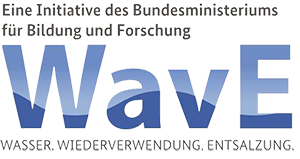Big desalination plant for small ions
Freshwater resources are decreasing worldwide, and coastal regions in particular are affected by the salinization of aquifers. This is why research into innovative and energy-efficient desalination processes, such as monovalent selective membrane-supported capacitive deionization, is needed in order to be able to meet the water demand. In the innovatION joint project, selective ion exchange membranes are used in an electrosorption process to remove mainly monovalent ions from saline groundwater.
At the beginning of the year, the upscaling of the ion exchange membranes began. In laboratory experiments at the Chair of Process Engineering in Hydrosystems at TU Dresden, these membranes demonstrated a two to ten times higher permeability of monovalent ions and thus led to a higher removal of nitrate, chloride and sodium via adsorption compared to polyvalent ions. At FUMATECH BWT GmbH and the Leibniz-Institut for Polymer Research Dresden e.V., not only did the formulation have to be expanded in terms of quantity, but the quality also had to be adapted to larger production machines and new production processes, which in turn influenced the selectivity of the membranes.
With the help of the fully automated measuring and control system from elkoplan staiger GmbH, the targeted removal of specific ions can also be optimized via process parameters such as the electrical voltage, the flow rate and an electrical pulse process. The pilot plant currently desalinates 10-30 l/h continuously, with hardly any cleaning required. However, the cell geometry can also influence the selectivity. Tracer-based flow measurements and simulations were carried out at the Chair of Process Engineering in Hydro Systems at TU Dresden, which can be used to improve the cell geometry in the future. With the help of optimized process settings, a water recovery of up to >70% and an energy consumption <1 kWh/m³ can be achieved. The advantages of the electrochemical process are the high flexibility of the system, which can be easily adapted to changing boundary conditions via the process settings, as well as the low cleaning effort.
The pilot plant for selective desalination is currently in operation at the waterworks on Langeoog belonging to the OOWV. A real enrichment of the freshwater lens on Langeoog is not possible. However, the Hydrogeology and Landscape Water Balance working group at the Carl von Ossietzky University of Oldenburg is currently carrying out modeling of the enrichment of the freshwater lens on Langeoog in order to be able to estimate the influence of the infiltrated partially desalinated water on the freshwater lens and on the saltwater intrusion in terms of time and location. Soil column experiments have already shown the positive effects of partially desalinated water compared to the infiltration of fully desalinated water.
Following the trials on Langeoog, the pilot plant will also be tested at the Nienburg District Association for Water Management from June in order to investigate the selective removal of nitrate.
You can find the complete WavE newsletter here:
bmbf-wave.de/Publications/Newsletter.html



